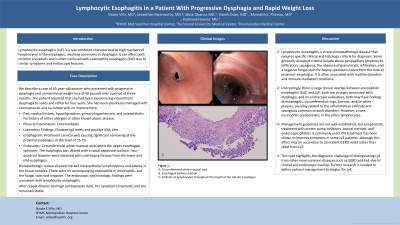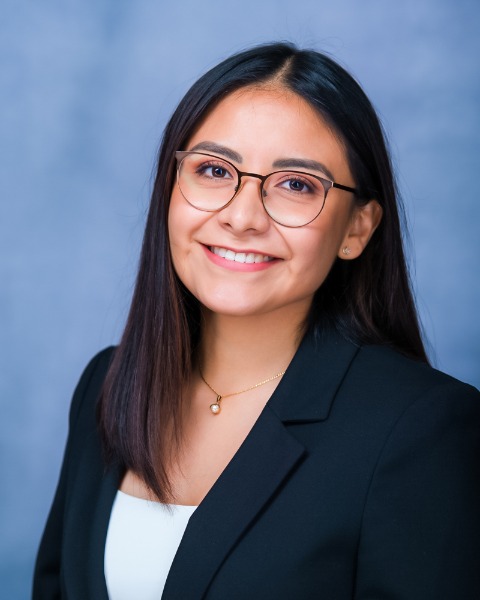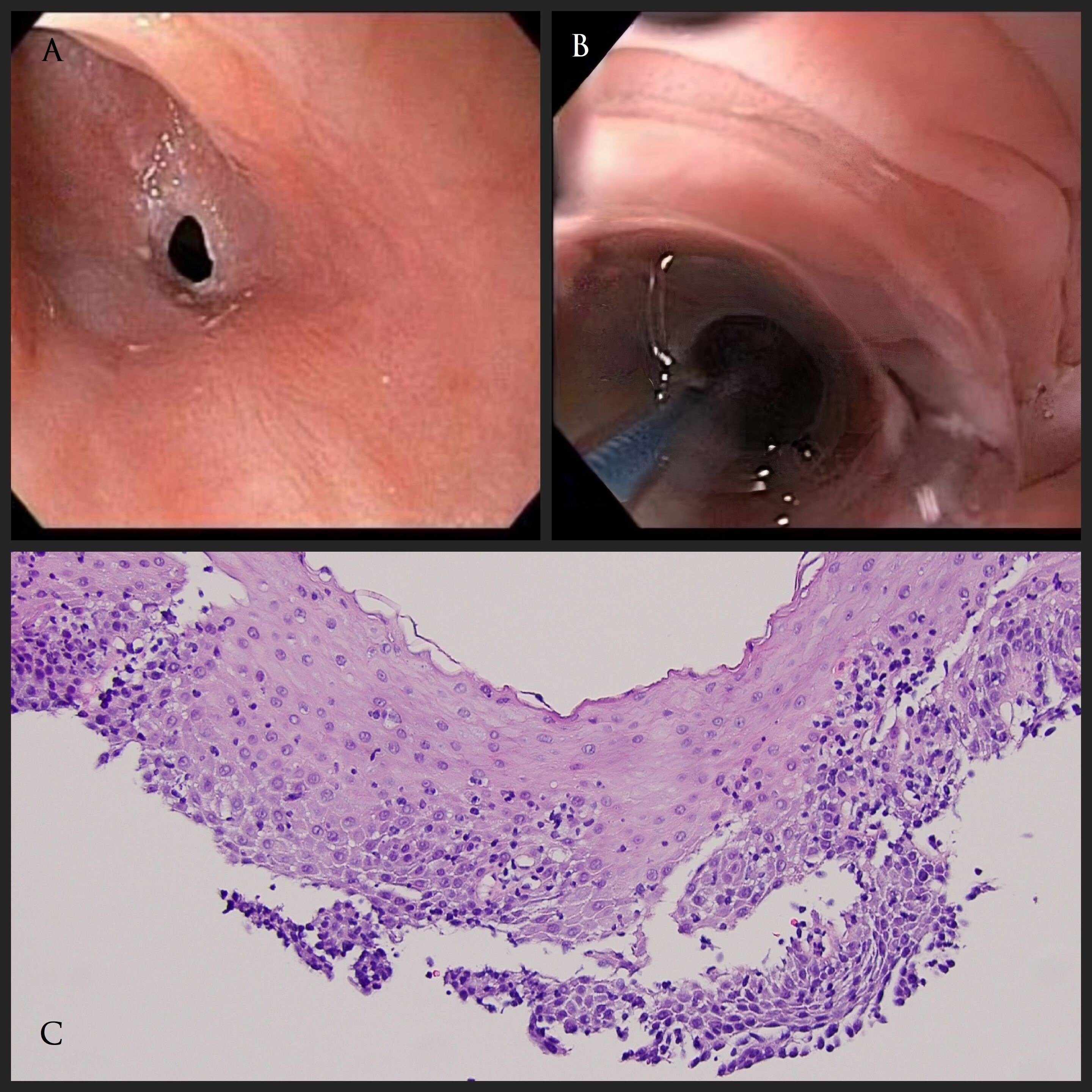Monday Poster Session
Category: Esophagus
P1866 - Lymphocytic Esophagitis in a Patient With Progressive Dysphagia and Rapid Weight Loss
Monday, October 23, 2023
10:30 AM - 4:15 PM PT
Location: Exhibit Hall

Has Audio

Nicole E. Villa, MD
Metropolitan Hospital Center
New York, NY
Presenting Author(s)
Jananthan Paramsothy, MD1, Nicole Villa, MD2, Steve Obanor, MBBS, MD3, Kadirawel Iswara, MD3, Meredith E. Pittman, MD3, Kaveh Zivari, MD3
1Richmond University Medical Center, Staten Island, NY; 2Metropolitan Hospital Center, New York, NY; 3Maimonides Medical Center, Brooklyn, NY
Introduction: Lymphocytic esophagitis (LyE) is a rare condition characterized by high numbers of lymphocytes in the esophagus, resulting commonly in dysphagia. It can affect both children and adults and is often confused with eosinophilic esophagitis (EoE) due to similar symptoms and endoscopic features.
Case Description/Methods: This case report describes a 65-year-old woman with progressive dysphagia and weight loss. Initial management with esomeprazole and sucralfate did not improve her symptoms. Physical examination was unremarkable. Laboratory testing was only significant for elevated IgA levels and positive ANA titers. Esophagram revealed a cervical web causing narrowing of the esophagus, which was confirmed by esophagogastroduodenoscopy. Biopsy samples showed intraepithelial lymphocytosis and edema, consistent with lymphocytic esophagitis. After repeat dilation and increased pantoprazole dose, her symptoms improved, and she remained stable.
Discussion: Lymphocytic esophagitis is a rare clinicopathologic disease that requires specific clinical and histologic criteria for diagnosis. Some generally accepted criteria include dense peripapillary lymphocytic infiltration, spongiosis, the absence of granulocytic infiltration, and a negative fungal stain for biopsy specimens taken from the mid- or proximal- esophagus. It is often associated with motility disorders and immune-mediated conditions. Interestingly, there is large clinical overlap between eosinophilic esophagitis (EoE) and LyE: both are strongly associated with dysphagia, and on endoscopic evaluation, both may have findings of esophagitis, circumferential rings, furrows, and/or white plaques, possibly related to the inflammatory infiltrate and spongiosis common to both disorders. However, in one, eosinophils predominate; in the other, lymphocytes.
Management guidelines are not well-established, but symptomatic treatment with proton pump inhibitors, topical steroids, and endoscopic dilation is commonly used. PPI treatment has been shown to improve symptoms in some LyE patients, although this effect may be secondary to coincident GERD relief rather than relief from LyE. This case highlights the diagnostic challenge of distinguishing LyE from other more common diseases such as GERD and EoE due to clinical and endoscopic overlap. Further research is needed to define optimal management strategies for LyE.

Disclosures:
Jananthan Paramsothy, MD1, Nicole Villa, MD2, Steve Obanor, MBBS, MD3, Kadirawel Iswara, MD3, Meredith E. Pittman, MD3, Kaveh Zivari, MD3. P1866 - Lymphocytic Esophagitis in a Patient With Progressive Dysphagia and Rapid Weight Loss, ACG 2023 Annual Scientific Meeting Abstracts. Vancouver, BC, Canada: American College of Gastroenterology.
1Richmond University Medical Center, Staten Island, NY; 2Metropolitan Hospital Center, New York, NY; 3Maimonides Medical Center, Brooklyn, NY
Introduction: Lymphocytic esophagitis (LyE) is a rare condition characterized by high numbers of lymphocytes in the esophagus, resulting commonly in dysphagia. It can affect both children and adults and is often confused with eosinophilic esophagitis (EoE) due to similar symptoms and endoscopic features.
Case Description/Methods: This case report describes a 65-year-old woman with progressive dysphagia and weight loss. Initial management with esomeprazole and sucralfate did not improve her symptoms. Physical examination was unremarkable. Laboratory testing was only significant for elevated IgA levels and positive ANA titers. Esophagram revealed a cervical web causing narrowing of the esophagus, which was confirmed by esophagogastroduodenoscopy. Biopsy samples showed intraepithelial lymphocytosis and edema, consistent with lymphocytic esophagitis. After repeat dilation and increased pantoprazole dose, her symptoms improved, and she remained stable.
Discussion: Lymphocytic esophagitis is a rare clinicopathologic disease that requires specific clinical and histologic criteria for diagnosis. Some generally accepted criteria include dense peripapillary lymphocytic infiltration, spongiosis, the absence of granulocytic infiltration, and a negative fungal stain for biopsy specimens taken from the mid- or proximal- esophagus. It is often associated with motility disorders and immune-mediated conditions. Interestingly, there is large clinical overlap between eosinophilic esophagitis (EoE) and LyE: both are strongly associated with dysphagia, and on endoscopic evaluation, both may have findings of esophagitis, circumferential rings, furrows, and/or white plaques, possibly related to the inflammatory infiltrate and spongiosis common to both disorders. However, in one, eosinophils predominate; in the other, lymphocytes.
Management guidelines are not well-established, but symptomatic treatment with proton pump inhibitors, topical steroids, and endoscopic dilation is commonly used. PPI treatment has been shown to improve symptoms in some LyE patients, although this effect may be secondary to coincident GERD relief rather than relief from LyE. This case highlights the diagnostic challenge of distinguishing LyE from other more common diseases such as GERD and EoE due to clinical and endoscopic overlap. Further research is needed to define optimal management strategies for LyE.

Figure: A: Circumferential white mucosal web
B: Esophageal balloon dilation
C: Infiltrate of lymphocytes throughout the length of the tubular esophagus
B: Esophageal balloon dilation
C: Infiltrate of lymphocytes throughout the length of the tubular esophagus
Disclosures:
Jananthan Paramsothy indicated no relevant financial relationships.
Nicole Villa indicated no relevant financial relationships.
Steve Obanor indicated no relevant financial relationships.
Kadirawel Iswara indicated no relevant financial relationships.
Meredith Pittman indicated no relevant financial relationships.
Kaveh Zivari indicated no relevant financial relationships.
Jananthan Paramsothy, MD1, Nicole Villa, MD2, Steve Obanor, MBBS, MD3, Kadirawel Iswara, MD3, Meredith E. Pittman, MD3, Kaveh Zivari, MD3. P1866 - Lymphocytic Esophagitis in a Patient With Progressive Dysphagia and Rapid Weight Loss, ACG 2023 Annual Scientific Meeting Abstracts. Vancouver, BC, Canada: American College of Gastroenterology.
